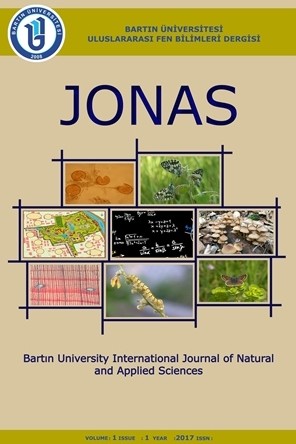THE EFFECT OF DAM RESERVOIRS IN FIRAT BASIN TO THE OUTDOOR TEMPERATURE PARAMETERS OF THE REGION CITIES
THE EFFECT OF DAM RESERVOIRS IN FIRAT BASIN TO THE OUTDOOR TEMPERATURE PARAMETERS OF THE REGION CITIES
Keban Dam, Karakaya Dam, Atatürk Dam, outdoor temperature, humidity meteorological data,
___
- 1. Akpinar S. & Akpinar E.K. (2010-a). Modeling of Climatic Parameters and Determination of Climatic Differences in the City of Elazig-Turkey and its Close Regions, Journal of Environmental Protection and Ecology, 1: 41-52.
- 2. Akpinar S.& Akpinar E.K. (2010-b). Modeling of Weather Data for the East Anatolia Region of Turkey, Journal of Urban and Environmental Engineering, 4(1), 9-22.
- 3. Apple L.S.C., Chow T.T., Square K.F.F. & Lin, J.Z. (2006). Generation of a Typical Meteorological Year for Hong Kong. Energy Conversion and Management, 47, 87–96.
- 4. Bacanli U.G. & Tugrul A.T. (2016). A Climate Impact of Dam Lake and Recep Yazicioglu Gökpinar Dam Lake Sample, Pamukkale University Journal of Engineering Sciences, 2(3), 154-159.
- 5. Bai Y., Xu Z., Zhang J., Mao D., Luo C., He Y., Liang G., Lu B., Bisesi M.S., Sun Q., Xu X., Yang W. & Liu Q. (2014). Regional Impact of Climate on Japanese Encephalitis in Areas Located Near the Three Gorges Dam, PLoS ONE, 9(1), 1-9.
- 6. Bicer A. (2019). Temperature and Relative Humidity Models of the Region Cities in Fırat Basin, Bartın University International Journal of Natural and Applied Sciences, 2(1),50-58.
- 7. Bicer A. (2020). Temperature and Relative Humidity Models of the Malatya City, MTU Journal of Engineering and Natural Sciences, 1(1), 11-18.
- 8. Bicer A. (2021). Analysis of Climatic Parameters with Meteorological Data of East Anatolia Region of Turkey, Bartın University International Journal of Natural and Applied Sciences, 4(1), 110-124.
- 9. Bulut H., Yesilata B. & Yesilnacar M.I. (2006). Determination of the Impact of Ataturk Dam Lake on Regional Climate by Trend Analysis, Proceedings of the fifth GAP engineering Congress, 26-28 April 2006, Sanliurfa-Turkey.
- 10. Cobanyilmaz P. & Yuksel U.D. (2013). Determination of Vulnerability of Cities to Climate Change: The Ease of Ankara, Suleyman Demirel University, Journal of Natural and Applied Science, 17(3): 39-50.
- 11. Degu A.M., Hossain F., Niyogi D., Pielke R., Hepherd J.M., Voisin N. & Chronis T. (2011). The Influence of Large Dams on Surrounding Climate and Precipitation Patterns, Geophysical Research Letters, 38(4), 1-7.
- 12. Dodman D. (2009). Blaming Cities for Climate Change An Analysis of Urban Greenhouse Gas Emissions Inventories, Environment and Urbanization, 21, 185-201.
- 13. Ekici A. (2008). Climate Impacts of GAP on Southeast Anatolia. MSc Thesis, İstanbul Technical University, İstanbul, Turkey.
- 14. Emall E., Sloan L.C. & Nychka D. (2001). Changes in Surface Air Temperature Caused by Desiccation of the Aral Sea, Journal of Climate, 14(3), 284-299.
- 15. Emiroglu M.E., Ozkan F. & Ozturk M. (1996). A Research on the Effects of Keban Dam Reservoir on Elazig Province Climate Conditions, Proceedings of the GAP I engineering Congress, 20-22 April 1996, 167-174, Sanliurfa-Turkey.
- 16. Fujihara Y., Tanaka K., Watanabe T., Nagan T. & Kojiri T. (2008). Assessing the Impacts of Climate Change on the Water Resources of the Seyhan River Basin in Turkey: Use of Dynamically Downscaled Data for Hydrologic Simulations, Journal of Hydrology, 353(1-2), 33-48.
- 17. Gyau-Boakye P. (2001). Environmental Impacts of the Akosombo Dam and Effects of Climate Change on the Lake Levels. Environment, Development and Sustainability, 3(1), 17-29.
- 18. Kadioglu M. (1994). Keban Barajı Öncesi ve Sonrasında Çevre İkliminin Franktal Analizi. Bayındırlık ve İskan Bakanlığı DSİ. Genel Müdürlüğü Su ve Toprak Kaynaklarının Geliştirilmesi Konferansı Bildirileri 3: 1087-1098, ANKARA.
- 19. Ozkan F. (1996). Investigation of the Effects of Keban Dam Lake on Elazig Region Climate Conditions, MSc Thesis, Firat University, Elazig, Turkey.
- 20. Sengun M.T. (2007). The Effect of Keban Dam Lake to Elazig Climate Under the Last Valuations Light, Eastern Anatolia Region Studies, 116-121.
- 21. TMSD (2020). Turkish Meteorological State Department, Climatological Service, Ankara, Turkey.
- 22. Tonbul S. (1986). Effects of Keban Dam on the Climate of Elazıg and its Surroundings, Geography Congress, 14-15 April 1986, Elazig, Turkey.
- 23. URL-1 (2021), https://www.mapsofworld.com/turkey/geography, June, 20, 2021.
- 24. Yılmaz S., Toy S., Irmak M.A. & Yilmaz H. (2007). Determination of Climatic Differences in Three Different Land Uses in the City of Erzurum, Building and Environment, 42(4), 1604–1612.
- Yayın Aralığı: Yılda 2 Sayı
- Başlangıç: 2017
- Yayıncı: Bartın Üniversitesi
ÜZÜMCÜ ÇAYI (BALIKESİR) FİTOPLANKTON EKOLOJİSİ
ISPARTA YÖRESİ EHRAMİ KARAÇAM AĞAÇLANDIRMALARININ DEĞERLENDİRİLMESİ: 30. YIL SONUÇLARI
KÜTAHYA YÖRESİ BAZI SİLVİKÜLTÜREL UYGULAMALARIN DEĞERLENDİRİLMESİ
Gülnur Saba ERTUĞRUL, Nebi BİLİR
Abayhan BURAN, Murat Ersin DURĞUN, Erhan KARAMAN
SÜRDÜRÜLEBİLİR HİDROJEN ÜRETİM TEKNOLOJİLERİ: BİYOKÜTLE TEMELLİ YAKLAŞIMLAR
